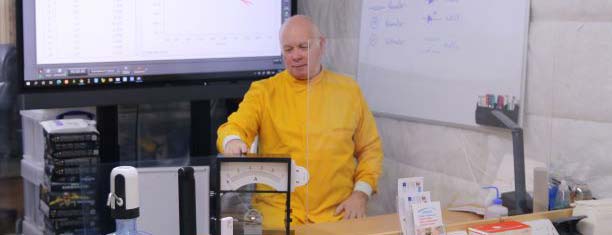I bought a Kipps apparatus to generate Carbon Dioxide Gas or Hydrogen Gas. I don't need very much or make it that often so gas cylinders are a waste of time. It is a fascinating piece of equipment which is so simple to use.The Kipps generator was invented in 1844 by Petrus Jacobus Kipp and was used throughout the rest of the 19th and the entire 20th centuries for making gases. Kipp generators are still being used in some places even now because of their ability to make a gas and then stop and then to be turned on again.
The Kipps apparatus is used to make a variety of gases such as Carbon Dioxide, Hydrogen and Hydrogen Sulphide. This is often why the Kipps apparatus was often left in a fume cupboard in the back of a classroom for all to see.
To make hydrogen gas some granulated zinc is put into the middle vessel by removing the stopper.
Acid is then poured into the top vessel which is connected by a glass tube to the bottom vessel.
When the chemist requires the gas the valve in the middle chamber is opened and this allows the acid in the top chamber to force by air pressure the acid in the lower chamber into the middle chamber. The acid mixes with the zinc and there is a reaction. The zinc reacts with the acid and generates hydrogen gas. If the valve is open then the gas is collected often under water into a gas jar.
When enough gas has been collected the valve is turned off. The pressure in the middle chamber starts to increase and pushes the acid out of the middle chamber back into the bottom and also into the top chamber. When all the acid has been removed the reaction stops because there is no longer any acid to react with the zinc.
The Kipps apparatus is very simple to use, interesting to understand how it works and gives a good insight to how old fashioned ideas are still good to use today
Friday 24 January 2014
Subscribe to:
Post Comments (Atom)
Chemistry visualising problems
Stereochemistry is very difficult to visualise, even sometimes when playing with models. Even looking at this, some students couldn't...

-
Negative feedback is a difficult concept to try and get over so I tried using a balance board and the @pascoscientific smart cart strapped...
-
Getting a classic set of results for the titration of NaOH and HCl is not that difficult but it is nice when we can get students to this ...
-
Mechanics: the grand meeting of Maths & Physics! Using strobe light & a ball drop for gravity-acceleration calculations and SUVAT fo...





No comments:
Post a Comment